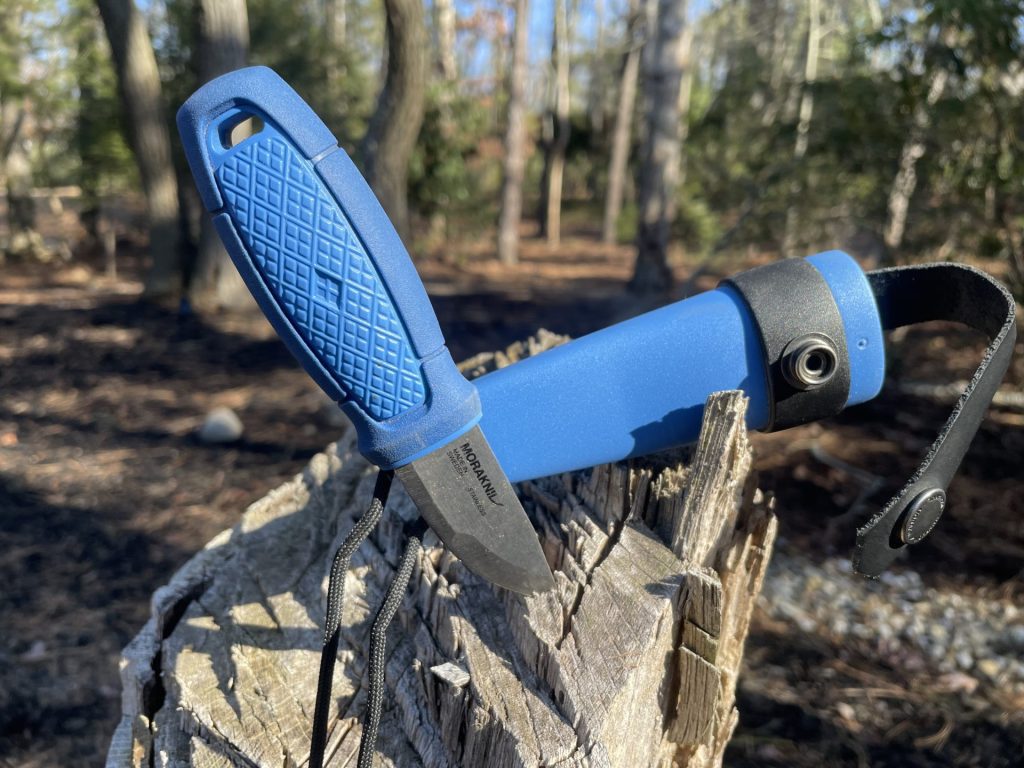
“Simplicity is the ultimate sophistication.” ~Leonardo da Vinci
If there’s one thing about Morakniv that’s made me feel like handing over some extra credit, it’s that Mora seems completely opposed to developing a folding knife. No matter how many knife companies seem to feed into the folder EDC craze, Mora just won’t budge.
Even companies like ESEE and OKC that run off their flagship models, options like the ESEE 4 or OKC RAT 3, produce folding alternatives like the Avispa and RAT II.
But Mora? They’re taking an “if it ain’t broke, don’t fix it attitude.” If it isn’t fixed, it seems like they want nothing to do with it.
So what can they offer the folks that don’t want to carry around a full-sized fixed blade?
Enter the Mora Eldris. This is the knife you can see me using in the background in my “Fire Hack: TInder from Wood,” post. (See below for the link.)
It may be small, but like the CJRB Maileah, it’s one heck of a little knife, and unlike the Maileah, it’s fixed, so it’s 110% tougher.
I’ll be the first to admit that it’s not the most exciting knife in my collection. If anything, the whimsically bright colors almost rob it of legitimacy. It looks almost like a toy.
But this little thing – the Mora Eldris – is anything but. Thanks to its quality materials and construction, paired with its small dimensions, it is unbelievably tough.
I have beat the pants off of my Mora Eldris, and it has come up every time asking for more. In all honesty, I can’t even say that, because it was never down.
This is a knife that I have used extensively as a shop knife when working on wood projects. I’ve made a few birdhouses and carved a few spoons using it, and I would confidently carry this on a camping trip or while hunting as my main fixed blade. It’s that good.
So let’s break down what makes it a winner.
Mora Eldris Specs

The Mora Eldris is a compact knife by any yardstick. It weighs all of 2.8 ounces, is 5.6” long overall and has quite a short blade, at just 2.3”. The blade is .08” thick.
The Mora Eldris features a stainless steel blade of 12C27 steel with a semi-matte finish. It is a straight backed blade profile, like most Mora Knives, with a modified Scandi grind. The spine is squared.
I do not know exactly what Mora has going on under the handle for a tang, but if the Eldris is anything like any other Mora Knife (you can buy blanks) then they have a partial tang, not a rat tail tang (more on this design below). However, considering the size of the Mora, even if it did have a rat tail tang, that would hardly constitute an issue (not defending rat tail tangs here, just saying).
The handles are made of two different polymers. The core of the handle is made with polypropylene and there is a textured TPE overmold that adds traction.There is a lanyard hole near the end of the handle.
The Edlris comes with a polymer sheath. It is sold with both belt and neck kits. The neck kit, which is the one I got from Sierra a few years back, comes with a secondary retention strap that adds extra security and a length of paracord that can be used to set it up as a neck knife. I think the secondary retention feature is leather but I am actually not certain.
That more or less covers the specs. So what makes this a great knife?
Steel, Blade Profile, Tang Construction
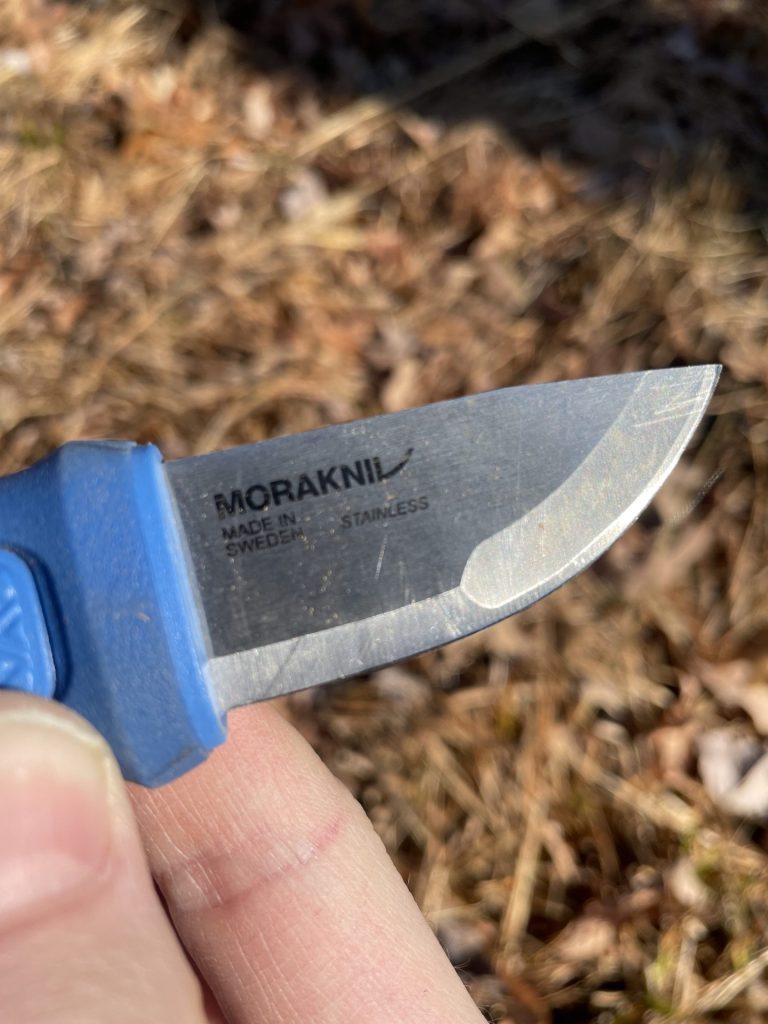
For such a tiny knife, I have a lot to say about the practicality of this knife blade and the steel used to make it.
First, let’s talk about the steel. Mora uses Sandvik 12C27 steel in the Mora. Though this is a budget steel, it has quite a lot of draws.
This alloy contains .6% carbon, 13.5% chromium, .4% manganese, and traces of silicon, phosphorus and sulfur.
According to Mora, this knife has a blade with an HRC hardness rating of 56 to 58; the company that produces the steel claims it lies about at 56. Of course, this has as much to do with heat treatment as chemistry.
What I can say is that the steel feels hard. When you use it to cut a hard wood, like oak, it doesn’t roll or blunt over the way softer steels like the XXCrXXMoV alloys tend to.
Unlike many of my other knives, I have extensively used my Mora Eldris for wood carving projects. I’ve carved spoons, bird houses, tool handles, and other similar items using this knife and a few others; after putting a good edge on it, I can carve through quite a bit of white oak or mulberry (both very hard woods) without any noticeable blunting.
So despite the fact that it has barely a half a percent of carbon, I’d say one of the defining features of this blade is its ability to take an edge Using a one-two combo with a soft and hard black Arkansas natural stone, I can get this thing sharp enough to shave, and it will stay that way for a while.
Which is another thing I want to point out. It can seem like some steel alloys fight you and make it difficult to establish a really sharp edge. This one is not like that. Not only does the Eldris come sharp, but getting a wicked edge on 12C27 only takes a few passes and a bit of stropping. You know how some knives are “scary sharp?” You can get the Eldris there.
The Eldris “officially” has a Scandi grind, but it’s unique among Mora knives in that this is a very shallow Scandi. Honestly, I wouldn’t even call it that. I’d call it a half flat, with a secondary bevel near the point of the blade (see below).
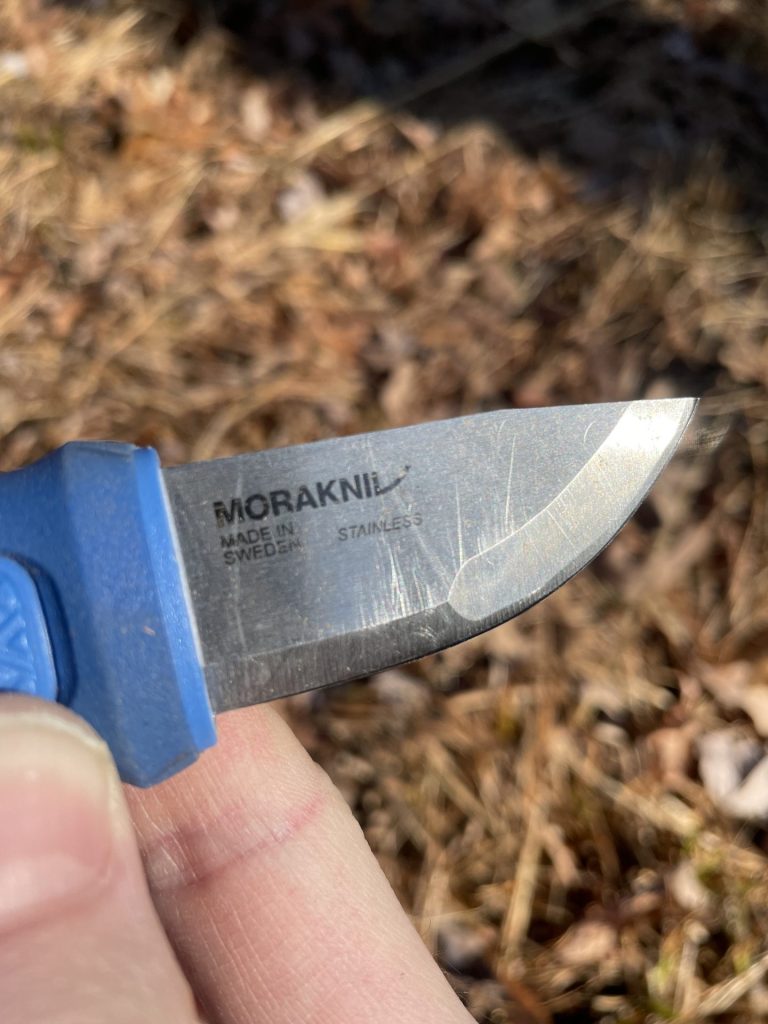
Part of the fact that you can get the knife so sharp has to do with the construction of the blade and not the alloy. It has a very thin blade (unlike many Mora knives) and a high Scandi grind and gently tapers off to the edge. I’m not sure what angle the two cheeks of the bevel meet at, but it’s very, very shallow.
So two big things to take away from this knife steel is that it both takes and holds an edge very well. The carbon sees to that.
With 13.5% chromium, this alloy is also very resistant to corrosion. Now, to be fair, I’m not sure what the actual “corrosion threshold” is for this steel, but I can say without a doubt it’s one of the most resistant steels I’ve used. I’ve used the Eldris in the rain without a second thought and hardly wiped it off, and it has never rusted. I’ve never brought it around saltwater, but corrosion is not something I’ve given half a thought to and the blade has never showed so much as a speck of rust.
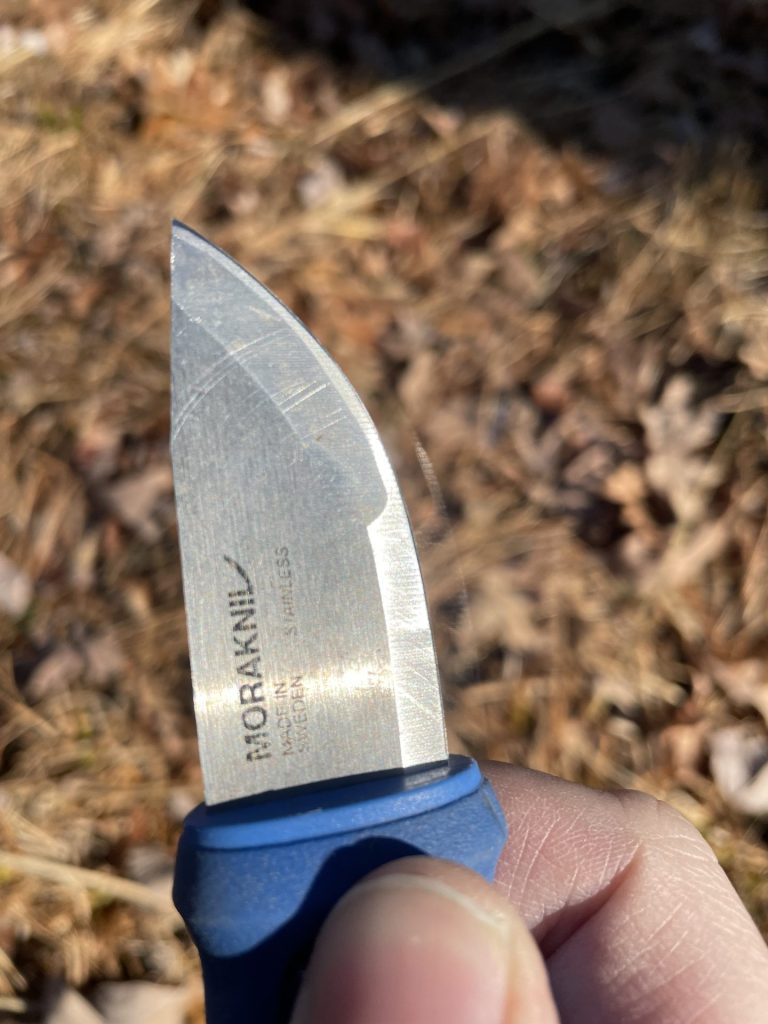
So, whatever the case, this steel is excellent for corrosion resistance. My experience may be limited here, though, since I haven’t used it in a marine environment. If any of you has, please let me know in the comments and I will amend this post.
One more thing. This is a very tough steel. Even with the partial tang, I have used the knife to split small scales and shingles of white ok and mulberry and it doesn’t show any signs of quitting. My guess is it has the perfect balance of carbon and manganese for this. These two elements enable the steel to remain both hard and tough, which frees it (mostly) from the risk of splitting or chipping.
In other words, you might be cautious about batoning with such a tiny knife, but I have done it extensively and I have never had an issue.
So the unique chemistry of this alloy, affordable as it is, gives it a good balance across the spectrum of edge retention, durability, and corrosion resistance.
How about the size and profile?
You don’t need me to tell you it’s tiny. This does limit it somewhat. The short reach limits its abilities as a baton and don’t even think about using this knife as a chopper.
But other than that, its size is pretty versatile. Like I said, I’ve used it extensively as a woodworking knife. The shallow grind enables it to make deep cuts pretty easily, but you can also shave very small slivers off of a wood blank with great facility. This makes it excellent for detail work, or for carving something akin to a featherstick,
The reach of the knife also limits it as a splitting implement, so while it is definitely tough enough to use for batoning, I wouldn’t make it my go to. More than likely Mora wasn’t imagining that scenario when they designed it, anyway. It’s just nice to know.
As a food prep knife I think it also shows promise. I’ve never used it to clean fish or small game but I think it would do a good job with those tasks.
The spine of the knife is squared perhaps perfectly, better than any other knife I own. This makes it really easy to strike a fire using the Eldris. As I demonstrated in my “Fire Hack: Tinder from Wood (a Seasoned Log)” post, you can use this knife to scrape very fine tinder off of a whole log.
Basically, whether you’re making a sandwich, cutting open a box, or carving a spoon or a featherstick, the Eldris is a really good bet.
The blade profile, being a perfect straight-backed design, is fairly nondescript. It’s good for lots of things. I can’t say much more than that.
Handle Material and Ergonomics
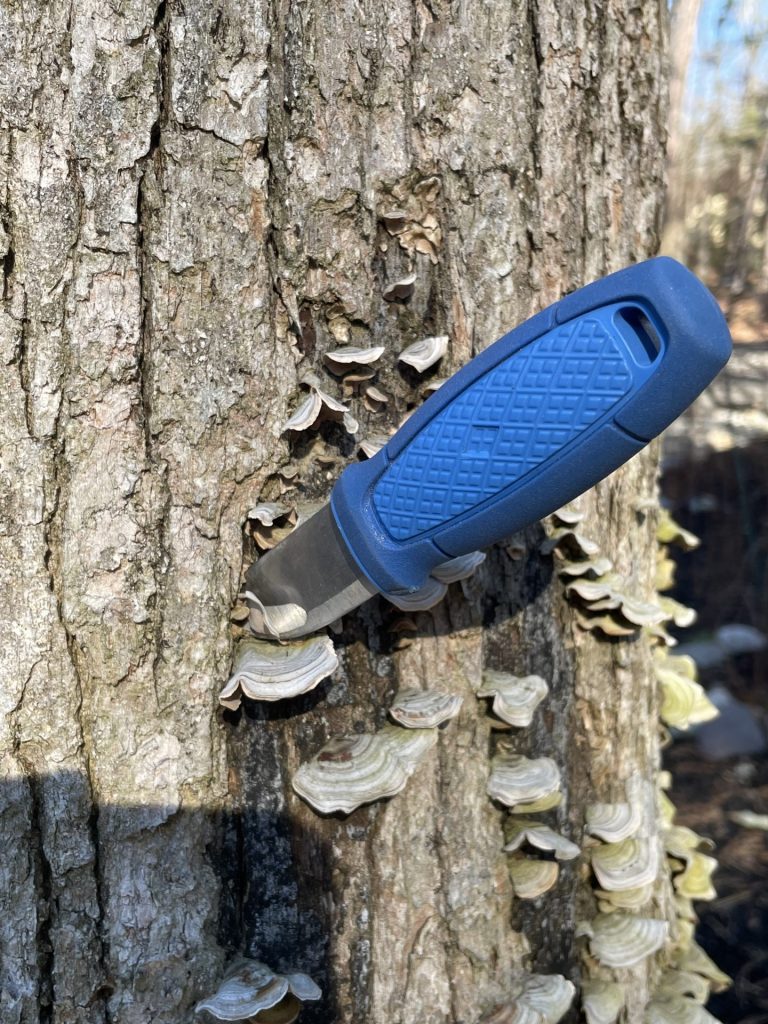
As much as I love the steel Mora uses, as well as the side and shape of the blade (and trust me, I do) I think where Mora may have really hit it out of the park is with the handle’s design, material, and ergonomics.
Alright, so first impressions. You see how bright blue this thing is, right?
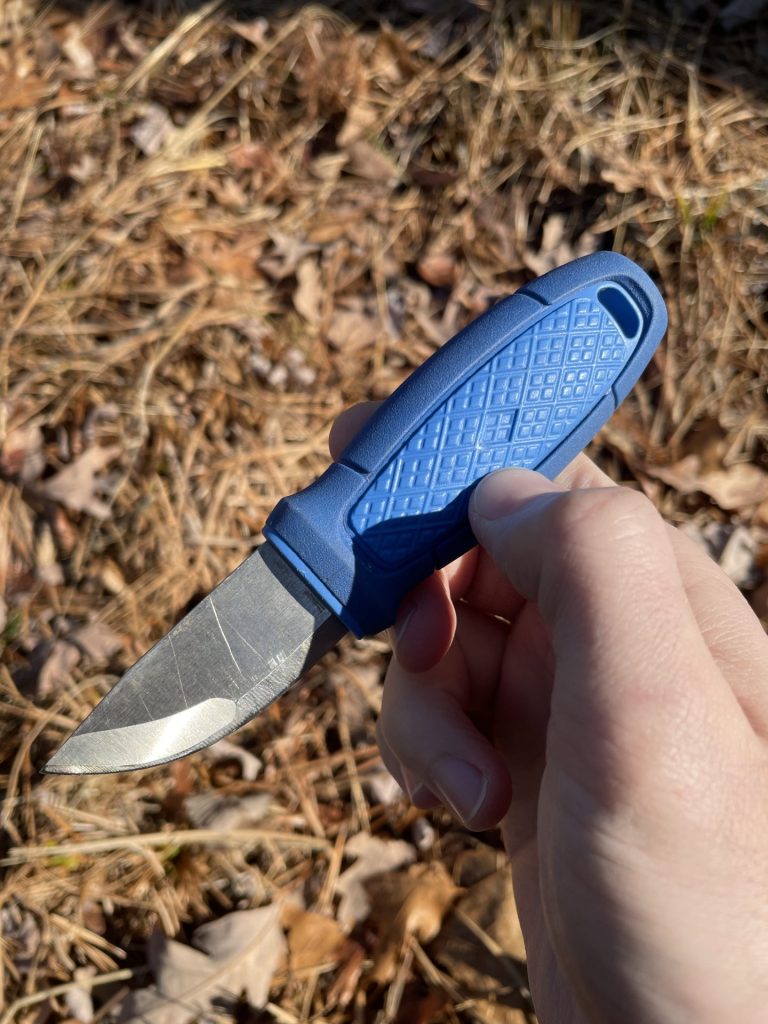
It almost looks garish. Bright colors in knives rarely if ever appeal to me. I bought this one because it was one of the least offensively colored Moras on the shelf that day. Mora also makes this in a sickeningly bright assortment of different colors, like orange and red. It is also available in a much more demure black (as well as Yoda-green, I have another in this color but I use the blue one more) but far and away, they’re brightly colored.
This does not appeal to me, but I see the utility in this decision. These were designed as accessory knives, backup knives at worst, and bushcraft knives at best. They’re the sort of thing you’d unsheath in camp or on the trail right?
Well, that sort of thing is also the sort of thing you’d be liable to place down among some leaf litter or wood chips. And I’d wager a respectable portion of the time, when you do that, you won’t ever be sheathing it again.
So, with that said, despite the fact that the bright colors don’t appeal to me, they make perfect sense for this knife. Love or hate my blue Eldris, I’m never going to lose this when I drop it in the leaves or high grass.
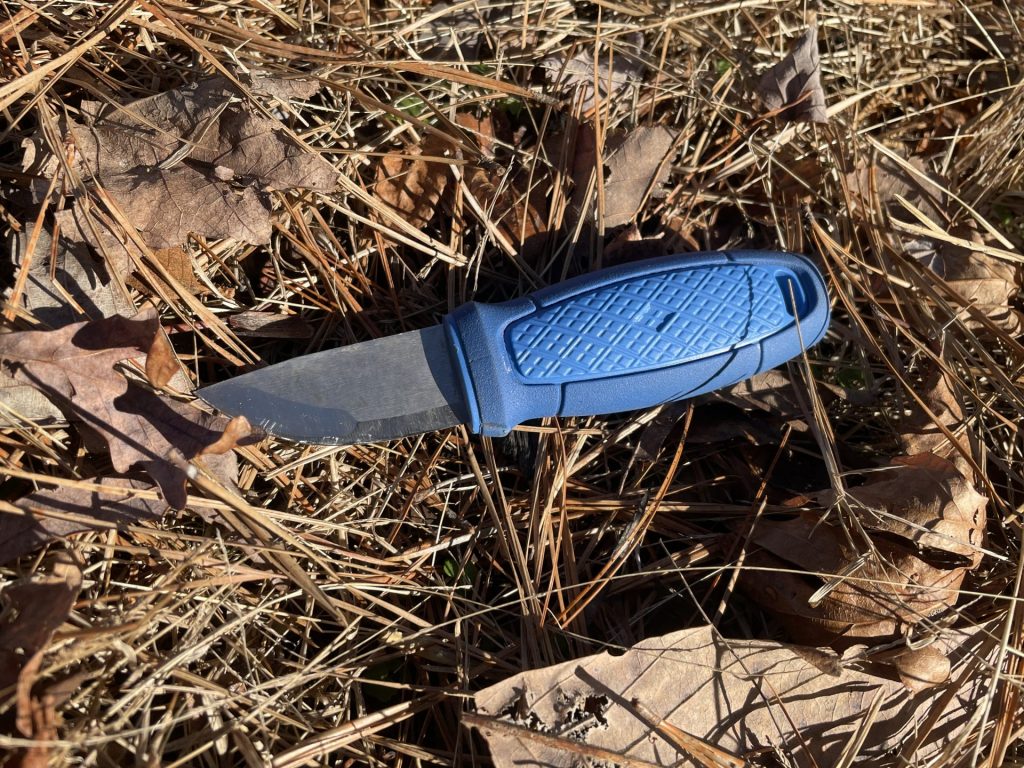
The handle size and shape are also killer designs. That might sound like high praise since this thing is a barely-machined piece of broomstick handle, but allow me to elaborate.
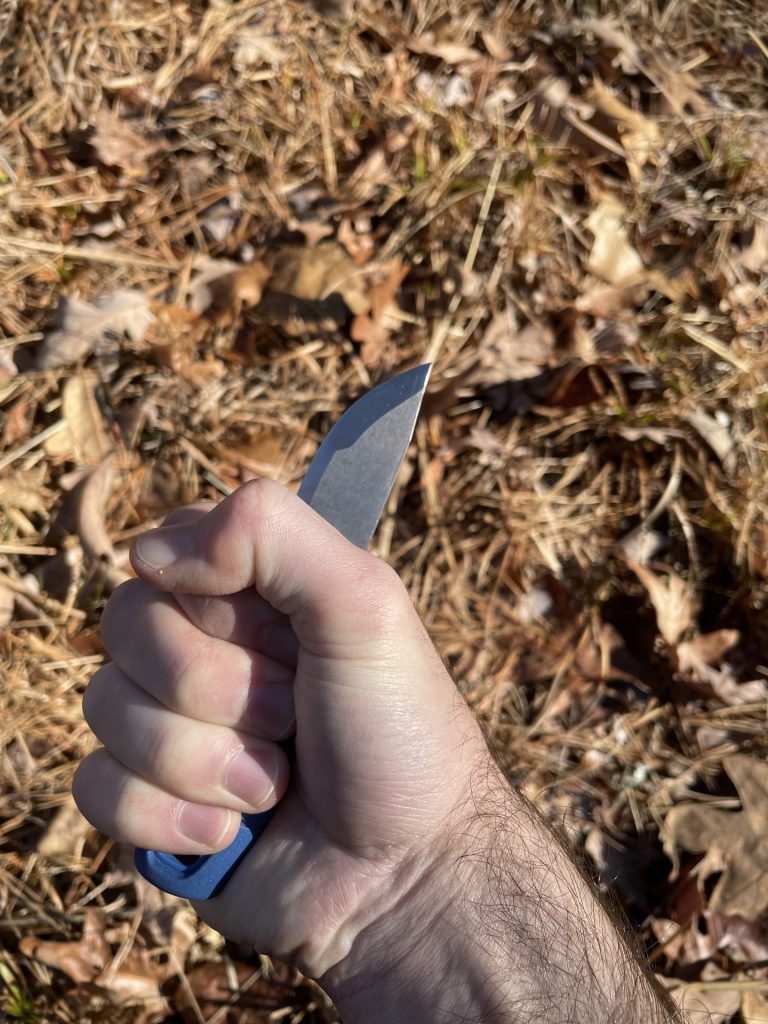
It looks simple, and you know what? It is. But the thing about this hande is that, as diminutive as it is, it really fills my hand, and I mean it fills it comfortably. Granted, I don’t have huge hands, but this thing feels like it fills my grip completely.
Closing your hand around the Mora Eldris is a thing of pure satisfaction. It almost feels like the ergs were precision tested to fit in the human grip, despite having any finger grooves or pronounced palm swells. For all I know, maybe Mora did do extensive ergonomic testing.
Take my word for what it’s worth until you get to handle one of these things in real life, but when I say this handle is both practical and comfortable, I mean it.
By the way, You can also hold the knife in the reverse grip and it’s just as practical:

Or, you can put it in the saber grip, and on a knife this small you can get your thumb all the way up on the point for extremely precise control:
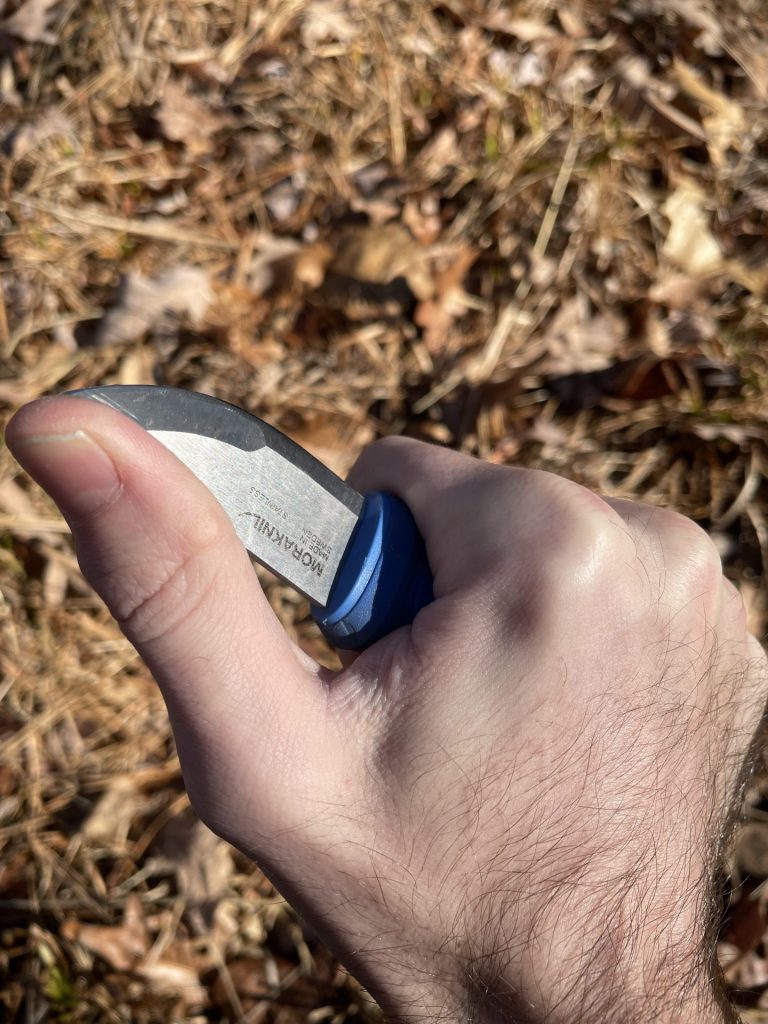
This doesn’t even paint the entire picture. You could machine a piece of tungsten in the size and shape of this Mora’s handle. It would be heavy and slick. The Eldris is not.
Quite the contrary, in fact. The Mora Eldris has a very pleasantly textured handle with a polypropylene core and two inserts or an overmold of TPE. This is a softer polymer; the polypropylene feels hard and the TPE feels almost gummy. The polypropylene core is also impressed with some sort of diamond pattern that makes it even more grippy.
Between the TPE overmold and the perfect sizing and dimensions of the Mora Eldris’s handle, I don’t think there’s any way you could realistically lose your grip. Maybe if your hands were really cold or greasy, but even that’s a stretch.
And, about sizing – it’s perfect. Again, I know I don’t have the biggest hands, but there’s just nothing wrong with the Eldris. It looks too small. I mean, it really looks too small. It even makes a concerted, convincing nonverbal argument that it is, in fact, too small – until you get the thing in your hands.
It’s not too small at all, in fact, it has a plumpness in the grip that makes it feel almost on the larger side.
Also, keeping on the thread of ergonomics. The uniquely lozenge-like, basically-rounded styling of this Mora’s handle means there are no hot-spots, I think Mora has categorically eliminated them, even in concept.
Despite the diminutive stature of this knife and the fact that it lacks a crossguard, I think Mora has done a standup job. The Mora Eldris is comfortable and secure in the grip – in a variety of grips, in fact.
Sheath and Carry Options

Just like the handle and steel, the Mora Eldris is a home run in terms of sheath and carry options.
It comes with a hard polymer sheath which may be polypropylene, the same thing the handle is made from. It sure feels like it. The Mora Eldris has two little divots in the sides of the polypropylene core that communicate with two ridges on the inside of the sheath. This offers a really satisfying form of primary retention that holds the knife fairly securely in the sheath. It’s impossible to knock it or drop it loose. It can only be removed with a deliberate tug.

I’m not sure how the base model of the Mora Eldris sells, but the one I got came with a neck knife kit. I know the base comes at least with the polymer (polypropylene sheath). Mine also came with a little leather(?) snap buckle and a length of paracord that could be used to make a neck knife out of it.
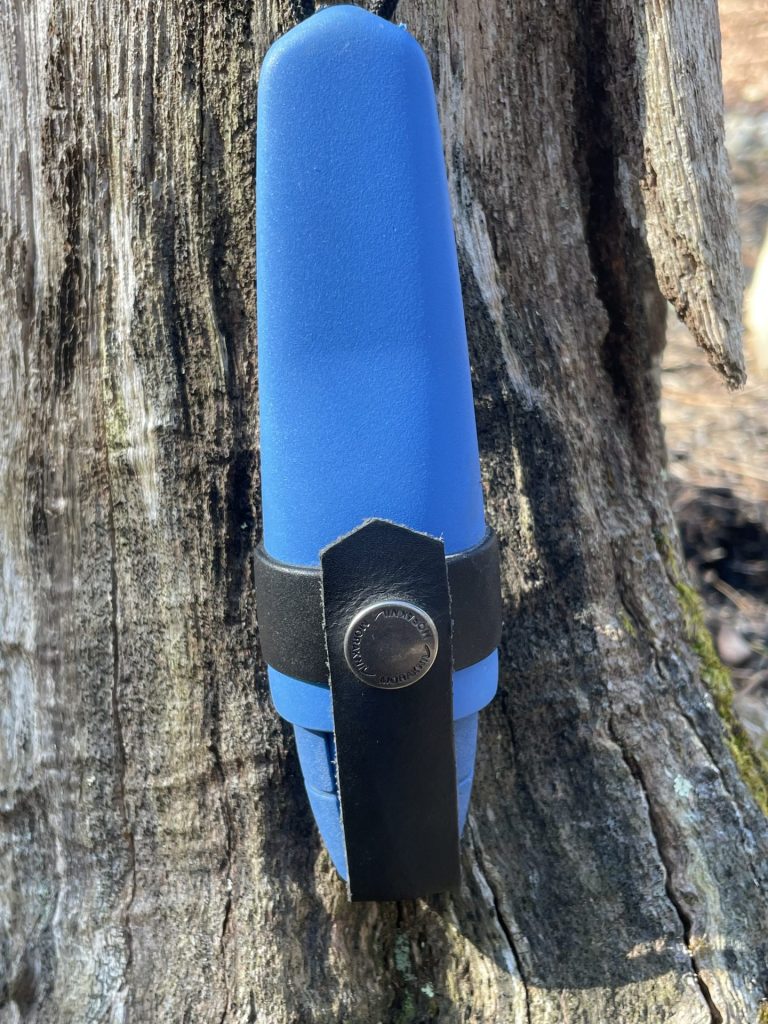
Now, as for me, I’m not one for neck knives, but when I was in the garage a few times carving wooden nonesuch, I did like the way wearing the Eldris around my neck kept it out of the way while I was working with my other tools until I needed it. It’s not something I could ever legitimately get used to, though.
However, there are a few things I really like about the neck knife configuration. Chiefly, I think the leather secondary retention feature is a huge win. It consists of a girdle of leather that encircles the throat of the sheath (very securely, might I add) and a second leather strap that curves over the top of the handle and snaps securely into place on the other side.
The primary retention feature of the Mora Eldris’ handle does well enough, even when practicing inverted carry. Using this secondary retention feature all but secures you’d never lose the knife.
Even though I don’t use this as a neck knife, I really like the engineering, however simple, Mora has put into it.
The one thing that’s a pain about the kit I got is there’s no way to carry this knife on a belt in this configuration. The only thing I could think of doing is rigging it to carry on the left side of one of my backpack’s straps, the way I do with some of my other knives.
However, in this configuration, belt carry is effectively out of the question. All the same, the knife is so small that you could probably stuff it, sheath and all, in one of your pockets, and it would hardly take up more space than a mediocre wallet. I know I could.
So for most of us, this limits it to use as a neck knife, carried free in a pocket, or rigged up some other way. There are belt kits you can buy to carry it on a belt, but I don’t have one so I can’t weigh in on it.
I will say this, though. Given the small size of the knife, and the even smaller dimensions of the handle, I can’t help but feel that it wouldn’t ride well on a belt. That is, it would definitely be out of the way and probably wouldn’t feel obtrusive, like some larger knives, but at the same time, I just feel like it would be hard to draw. I never tried though.
If one of you has carried a Mora Edlris on your belt and has something to contribute, by all means let me know in the comments and I will adjust the blog with your insights.
All in all, it’s rigged great the way it is even though I don’t carry it the way it’s intended. That hardly bothers me because I actually rarely carry this knife; I just use it as a shop knife or a carver when I’m around the house.
Can Mora Do Anything Better?
Not really, people. Let this knife be what it is. If there was anything I could possibly think of changing about this knife, it would be to add some sort of choil or crossguard to the knife because, I’ll be honest, I get this thing so sharp that sometimes it makes me nervous how close my fingers are to the edge, and that there’s nothing between them.
But, at this size, it would be impossible to work a crossguard into the design. It would also utterly destroy the ergonomics of the knife. So would a choil, and if you have taken note of what I’ve said already in this post, the knife really wants nothing for ergonomics. So, really, that’s hardly a concern. It’s not slip prone.
The other thing is maybe it could be just a tad bigger? But that also would defeat the purpose. It is what it is because of its size. If it was larger, it wouldn’t be a Mora Eldris. I could also just use a larger tool when the occasion calls for it. So let’s remember what this knife is and what it does well rather than trying to change it.
Maybe also it would be beneficial for Mora to sell this thing with an option for belt carry for those who practice that, which is, like, you know, basically everyone. But like I mentioned already, I don’t think that’s a massive detractor.
I say, this is an excellent answer on behalf of Mora to the folder craze, and I’m not entirety disappointed that Mora has stuck to its guns and refuses to cow. There are no folders in the Mora line, and I’m not complaining if this is the worst they can possibly muster.
Hopefully You’re Still with Me!
Alright, so that was one of the longest reviews I’ve ever published. I didn’t intend for it to go on that long when I started typing, but I got pretty much everything I had off my chest, down to steel chemistry and the secondary retention features of the sheath.
That’s all I got. The Mora Eldris is a great knife by any yardstick, and despite the fact that it’s tiny, it has to be one of the toughest knives in my collection, and very comfortable in the hand!
If you have anything you’d like me to have covered here, leave it in the comments and I’ll update.
Stay sharp.
~The Eclectic Outfitter
Such a super review!
Is it the perfect knife? No, because that don’t exist.
But it’s really good and lighter than some folders.
And with the addition of Eldris lightduty there is a cheaper option.
I completely agree that there is no “perfect” knife. It really depends on intended application.
I have the black version, attached to the bottom of the sheath with paracord I have a Kershaw ferro rod and a Jet Scream whistle. It’s a fantastic knife, no frills but touches all the bases.
FWIW Eldris translated from Swedish means “old rice”.
I carry the eldris on my belt. I purchased a kydex sheath for it and a cold steel small c clip. I carry it horizontally on my belt and hardly know it’s there. The draw is super easy too. I really enjoyed your review. I find it spot on. What a great little knife!!!
Thanks for reading! I personally don’t usually carry the Eldris daily but I love it as a carving knife and I’m thoroughly impressed by the ergonomics and blade steel. I’ve actually taken to carrying an Izula when I have a fixed blade on me in the field. If you liked this post, take a look at my Izula mods post!